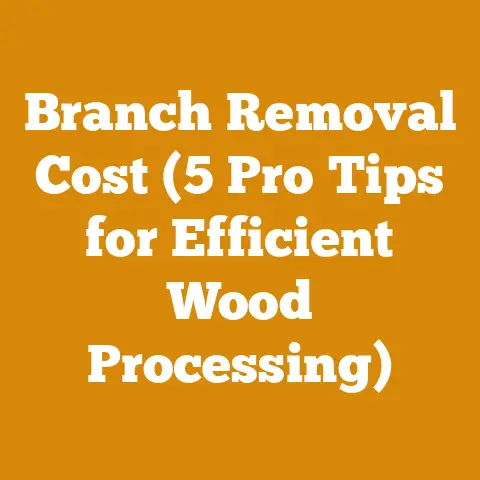How to Mark Property Lines (Woodland Boundaries) for Safe Logging
It was back in ’08, knee-deep in mud on my uncle’s property, attempting to clear a section for replanting. I was young, eager, and armed with a brand new chainsaw. What I lacked was a clear understanding of where my uncle’s property actually ended and our neighbor’s began. Let’s just say a slightly awkward conversation, a hastily erected temporary fence, and a very valuable lesson learned about the critical importance of properly marked woodland boundaries followed. That day, I realized marking property lines isn’t just about avoiding neighborly disputes; it’s about safe logging, ethical harvesting, and long-term forest management.
So, you’re staring at a stand of timber, ready to harvest or clear, but you’re unsure where your property ends and your neighbor’s begins. You’re not alone. Knowing how to accurately mark your property lines is absolutely vital for responsible woodland management and safe logging operations. This article will guide you through the process, step-by-step, ensuring you stay within your boundaries and avoid costly mistakes.
1. Understanding the Importance of Property Line Identification
Before even thinking about setting foot in the woods with marking paint, it is crucial to understand why identifying your property lines is so important. It goes far beyond just legal compliance.
- Legal Compliance: First and foremost, harvesting timber on someone else’s land is illegal and can result in hefty fines, lawsuits, and even criminal charges. Accurate property lines prevent accidental trespass and ensure you’re operating within the law.
- Neighborly Relations: Clear boundaries foster good relationships with your neighbors. Avoiding disputes over property lines is essential for long-term peace of mind and cooperation on shared resources.
- Sustainable Forestry: Knowing your boundaries allows you to manage your woodland sustainably. You can plan harvests, replanting, and other management activities with confidence, knowing the extent of your resources.
- Safety: Accurate property lines ensure that logging operations are conducted safely. Felling trees near a boundary without knowing its exact location can lead to dangerous situations and potential damage to neighboring property.
- Avoiding Costly Mistakes: Harvesting timber on the wrong property can lead to significant financial losses, including the cost of replacing the timber and potential legal fees.
- Protecting Valuable Assets: Your woodland is a valuable asset. Proper boundary marking protects your investment by preventing encroachment and ensuring that you retain ownership of your land.
2. Gathering Essential Documents and Information
Before heading into the woods, arm yourself with the right information. This step is absolutely critical for accuracy.
- Deed: Your property deed is the primary document that describes your property’s boundaries. It contains the legal description of your land, which is essential for locating your property lines.
- Plat Map: A plat map is a visual representation of your property, showing its dimensions, boundaries, and any easements or rights-of-way. It provides a clear overview of your property’s layout.
- Survey Records: If your property has been surveyed, obtain the survey records from the surveyor or local government. These records contain precise measurements and markers that can help you locate your property lines.
- Previous Boundary Agreements: If you have any existing agreements with your neighbors regarding property lines, gather those documents as well. These agreements may clarify boundary locations and resolve any disputes.
- GPS Coordinates: If available, obtain the GPS coordinates of your property corners. These coordinates can be used with a GPS device to accurately locate your property lines in the field.
- Neighbor Contact Information: Having your neighbor’s contact information can be helpful if you need to discuss boundary locations or resolve any questions.
3. Researching Property Records and Surveys
Once you have your documents, take the time to research and understand them. Don’t just assume you know what they say.
- County Recorder’s Office: Visit your county recorder’s office to access property records, deeds, plat maps, and survey records. These records are public information and can provide valuable insights into your property’s boundaries.
- Surveyor’s Office: Contact a local surveyor to obtain survey records and information about your property. Surveyors can also provide expert advice on boundary locations and property line disputes.
- Online Resources: Many counties and states offer online resources for accessing property records and maps. These resources can save you time and effort in researching your property’s boundaries.
- Review Legal Descriptions: Carefully review the legal descriptions in your deed and survey records. Pay attention to metes and bounds, which are descriptions of property boundaries using distances and directions.
- Identify Monuments and Markers: Look for mentions of monuments, such as iron pipes, concrete markers, or trees, in your property descriptions. These monuments serve as physical markers of your property corners.
- Understand Easements and Rights-of-Way: Be aware of any easements or rights-of-way that may affect your property boundaries. These easements grant others the right to use a portion of your land for specific purposes, such as utilities or access.
4. Locating Existing Boundary Markers
The next step is to actually get out into the woods and look for existing markers. This can be challenging, but it’s worth the effort.
- Metal Detectors: Use a metal detector to locate buried iron pipes or other metal markers. These markers are often used to mark property corners.
- GPS Devices: Use a GPS device to navigate to the GPS coordinates of your property corners. This can help you locate markers that may be hidden or obscured.
- Landmark Trees: Look for trees that are marked with blazes (marks made by ax or hatchet) or paint. These trees may serve as boundary markers.
- Stone Monuments: Search for stone monuments or piles of stones that may mark property corners. These monuments are often found in older properties.
- Fences: Existing fences may follow property lines, but it’s important to verify their accuracy with your property records. Fences can be moved or misaligned over time.
- Corner Posts: Look for corner posts, which are often made of wood or metal and are placed at property corners. These posts may be marked with numbers or letters.
- Persistence: Finding existing boundary markers can be challenging, especially in overgrown or wooded areas. Be persistent and patient in your search.
5. Using GPS Technology for Accurate Boundary Mapping
GPS technology has revolutionized the way we locate and map property boundaries. If you have access to a GPS unit, use it!
- High-Accuracy GPS Units: Invest in a high-accuracy GPS unit that is designed for surveying and mapping. These units provide more precise location data than consumer-grade GPS devices.
- Load GPS Coordinates: Load the GPS coordinates of your property corners into your GPS unit. This will allow you to navigate directly to those points in the field.
- Differential Correction: Use differential correction to improve the accuracy of your GPS readings. Differential correction uses data from a base station to correct errors in GPS signals.
- Record Waypoints: As you locate property corners, record waypoints in your GPS unit. These waypoints will serve as a record of your boundary locations.
- Create a Map: Use GPS software to create a map of your property boundaries. This map can be used for planning logging operations and other land management activities.
- Verify Accuracy: Verify the accuracy of your GPS measurements by comparing them to your property records and survey data.
- Battery Life: Ensure your GPS unit has sufficient battery life for your field work. Carry extra batteries or a portable charger.
6. Marking Your Property Lines with Durable Materials
Once you’ve located your property lines, it’s time to mark them clearly and durably. The materials you use should be weather-resistant and long-lasting.
- Surveyor’s Tape: Use brightly colored surveyor’s tape to mark trees along your property lines. Tie the tape securely to the trees so that it won’t come loose.
- Boundary Paint: Use boundary paint to mark trees and other objects along your property lines. Choose a paint color that is easily visible and long-lasting. (Typically a bright, durable red or orange).
- Metal Posts: Install metal posts at property corners and along property lines. These posts should be driven deep into the ground and marked with your property information.
- Wooden Stakes: Use wooden stakes to mark property lines, especially in areas where metal posts are not practical. Treat the stakes with a preservative to prevent rot.
- Reflective Markers: Use reflective markers to make your property lines more visible at night. These markers can be attached to trees, posts, or stakes.
- Permanent Markers: Consider using permanent markers, such as concrete monuments or iron pipes, to mark your property corners. These markers provide a long-lasting and reliable indication of your property boundaries.
- Documentation: Keep a record of the materials you used and the locations where you placed them. This will help you maintain your property lines over time.
7. Working with a Professional Surveyor
If you’re unsure about your property lines or if you’re facing a boundary dispute, it’s best to consult with a professional surveyor.
- Licensed Surveyor: Hire a licensed surveyor to survey your property and establish your property lines. A licensed surveyor has the expertise and equipment to accurately determine your boundaries.
- Boundary Survey: Request a boundary survey, which is a detailed survey that establishes the precise location of your property lines.
- Record of Survey: Ask the surveyor to file a record of survey with the county recorder’s office. This record will provide legal documentation of your property boundaries.
- Expert Testimony: If you’re involved in a boundary dispute, a surveyor can provide expert testimony in court to support your claim.
- Cost Considerations: Be aware of the costs associated with hiring a surveyor. Surveying can be expensive, but it’s a worthwhile investment to protect your property rights.
- Choosing a Surveyor: Choose a surveyor who is experienced in boundary surveying and who has a good reputation in your area.
- Communication: Communicate clearly with the surveyor about your needs and expectations.
8. Communicating with Neighbors
Open communication with your neighbors is crucial for maintaining good relationships and preventing boundary disputes.
- Inform Neighbors: Inform your neighbors of your plans to mark your property lines. This will give them an opportunity to ask questions or express any concerns.
- Joint Boundary Marking: Consider marking your property lines jointly with your neighbors. This can help ensure that everyone agrees on the boundary locations.
- Boundary Agreements: If you and your neighbors agree on the location of your property lines, consider entering into a written boundary agreement. This agreement can provide legal documentation of your boundaries.
- Respectful Dialogue: Maintain a respectful and open dialogue with your neighbors. Listen to their concerns and try to find mutually agreeable solutions.
- Mediation: If you’re facing a boundary dispute that you can’t resolve on your own, consider mediation. A mediator can help you and your neighbors reach a compromise.
- Documentation: Keep a record of all communications with your neighbors regarding property lines.
- Professionalism: Maintain a professional and courteous demeanor in all your interactions with your neighbors.
9. Maintaining Your Marked Boundaries
Marking your property lines is not a one-time task. Regular maintenance is essential to ensure that your boundaries remain clear and accurate.
- Regular Inspections: Inspect your property lines regularly, especially after storms or other events that could damage or displace boundary markers.
- Replace Damaged Markers: Replace any damaged or missing boundary markers promptly.
- Clear Vegetation: Clear vegetation around boundary markers to ensure that they remain visible.
- Repaint Markers: Repaint boundary markers as needed to maintain their visibility.
- Update Records: Update your property records and maps as needed to reflect any changes to your property boundaries.
- Document Maintenance: Keep a record of all maintenance activities you perform on your property lines.
- Long-Term Planning: Develop a long-term plan for maintaining your property lines.
10. Understanding Legal Considerations
Finally, it’s important to understand the legal considerations related to property boundaries.
- Adverse Possession: Be aware of the concept of adverse possession, which allows someone to claim ownership of land that they have occupied openly, notoriously, and continuously for a certain period of time.
- Easements: Understand the impact of easements on your property boundaries. Easements grant others the right to use a portion of your land for specific purposes.
- Boundary Disputes: Be prepared to resolve boundary disputes through negotiation, mediation, or litigation.
- Legal Advice: Seek legal advice from an attorney if you’re facing a complex boundary issue.
- State Laws: Be familiar with the state laws that govern property boundaries in your area.
- Local Ordinances: Be aware of any local ordinances that may affect your property boundaries.
- Due Diligence: Exercise due diligence in researching and understanding your property boundaries.
Project Metrics for Wood Processing and Firewood Preparation
Now that you’ve got your property lines clearly marked, let’s talk about making your wood processing and firewood preparation operations as efficient and profitable as possible. This is where tracking key project metrics comes in. I’ve found that consistently monitoring these metrics not only streamlines operations but also significantly improves the bottom line.
Why Track Project Metrics?
Think of it like this: you wouldn’t drive a car without a speedometer or a fuel gauge, would you? Similarly, running a wood processing or firewood operation without tracking key metrics is like flying blind. You might get somewhere, but you won’t know how efficiently you’re getting there, how much it’s costing you, or where you could improve.
Tracking these metrics allows you to:
- Identify Inefficiencies: Pinpoint areas where you’re wasting time, materials, or money.
- Optimize Processes: Fine-tune your methods to maximize yield and minimize waste.
- Make Data-Driven Decisions: Base your choices on concrete data rather than gut feelings.
- Improve Profitability: Ultimately, increase your profits by reducing costs and boosting efficiency.
- Monitor Progress: Track your progress over time and see the impact of your improvements.
Here are the key metrics that I’ve found most valuable in my own wood processing and firewood preparation operations:
-
Wood Volume Input:
- Definition: The total volume of raw wood (logs, rounds, or unprocessed timber) entering your processing operation. This is typically measured in cubic feet, cords, or board feet, depending on the scale of your operation.
- Why it’s Important: This metric is the foundation for calculating yield and efficiency. Without knowing how much wood you’re starting with, you can’t accurately assess how much you’re producing.
- How to Interpret it: Track this metric over time to identify trends in wood availability and pricing. A consistent supply of wood at a reasonable price is crucial for profitability.
- How it Relates to Other Metrics: Directly related to wood volume output, waste percentage, and overall profitability.
-
Wood Volume Output:
-
Definition: The total volume of processed wood (firewood, lumber, wood chips, etc.) that you produce. Measured in the same units as wood volume input (cubic feet, cords, board feet, etc.).
- Why it’s Important: This metric tells you how much product you’re actually generating from your raw materials.
- How to Interpret it: Compare this metric to wood volume input to calculate your yield percentage. A higher output volume indicates greater efficiency.
- How it Relates to Other Metrics: Directly related to wood volume input, yield percentage, and revenue.
-
Yield Percentage:
-
Definition: The percentage of raw wood that is converted into usable product. Calculated as (Wood Volume Output / Wood Volume Input) x 100.
- Why it’s Important: This is a key indicator of your operation’s efficiency. A low yield percentage means you’re wasting wood.
- How to Interpret it: Aim for a high yield percentage by optimizing your cutting techniques, minimizing waste, and utilizing all usable wood.
- How it Relates to Other Metrics: Directly related to wood volume input, wood volume output, waste percentage, and cost of goods sold.
- Example: If you start with 10 cords of wood and produce 7 cords of firewood, your yield percentage is (7/10) x 100 = 70%.
-
Waste Percentage:
-
Definition: The percentage of raw wood that is discarded as waste (sawdust, bark, unusable pieces). Calculated as (Waste Volume / Wood Volume Input) x 100.
- Why it’s Important: High waste percentages represent lost revenue and increased disposal costs.
- How to Interpret it: Minimize waste by using efficient cutting techniques, selling or repurposing byproducts, and properly disposing of waste materials.
- How it Relates to Other Metrics: Directly related to wood volume input, yield percentage, cost of disposal, and potential revenue from byproducts.
- Example: If you start with 10 cords of wood and generate 3 cords of waste, your waste percentage is (3/10) x 100 = 30%.
-
Processing Time per Unit:
-
Definition: The amount of time it takes to process a unit of wood (e.g., a cord of firewood, 1000 board feet of lumber). Measured in hours or minutes.
- Why it’s Important: This metric indicates your processing efficiency. Faster processing times mean you can produce more product with the same resources.
- How to Interpret it: Optimize your workflow, invest in efficient equipment, and train your staff to reduce processing time.
- How it Relates to Other Metrics: Directly related to labor costs, equipment downtime, and overall productivity.
- Example: If it takes 8 hours to process one cord of firewood, your processing time per unit is 8 hours/cord.
-
Labor Costs per Unit:
-
Definition: The cost of labor associated with processing a unit of wood. Calculated as (Total Labor Costs / Wood Volume Output).
- Why it’s Important: Labor costs are a significant expense in most wood processing operations.
- How to Interpret it: Reduce labor costs by improving efficiency, automating tasks, and optimizing staffing levels.
- How it Relates to Other Metrics: Directly related to processing time per unit, equipment downtime, and overall profitability.
- Example: If your total labor costs are $400 and you produce 5 cords of firewood, your labor cost per unit is $400/5 = $80/cord.
-
Equipment Downtime:
-
Definition: The amount of time that equipment is out of service due to breakdowns, maintenance, or repairs. Measured in hours or days.
- Why it’s Important: Downtime reduces productivity and increases costs.
- How to Interpret it: Implement a regular maintenance schedule, invest in reliable equipment, and train your staff to properly operate and maintain equipment.
- How it Relates to Other Metrics: Directly related to processing time per unit, labor costs, and overall productivity.
- Example: If your firewood processor is down for 4 hours per week due to maintenance, your equipment downtime is 4 hours/week.
-
Fuel Consumption:
-
Definition: The amount of fuel consumed by your equipment (chainsaws, tractors, processors) per unit of wood processed. Measured in gallons or liters per cord/board foot.
- Why it’s Important: Fuel is a significant operating expense, especially with rising energy costs.
- How to Interpret it: Use fuel-efficient equipment, optimize your cutting techniques, and properly maintain your equipment to reduce fuel consumption.
- How it Relates to Other Metrics: Directly related to operating costs, processing time per unit, and environmental impact.
- Example: If your chainsaw consumes 1 gallon of fuel to process one cord of firewood, your fuel consumption is 1 gallon/cord.
-
Moisture Content (Firewood Specific):
-
Definition: The percentage of water in your firewood. Measured using a moisture meter.
- Why it’s Important: Dry firewood burns more efficiently and produces less smoke.
- How to Interpret it: Aim for a moisture content of 20% or less for optimal burning. Season firewood properly by stacking it in a well-ventilated area for at least six months.
- How it Relates to Other Metrics: Directly related to fuel efficiency, customer satisfaction, and sales price.
- Example: Firewood with a moisture content of 25% will burn less efficiently than firewood with a moisture content of 15%.
-
Customer Satisfaction:
-
Definition: A measure of how satisfied your customers are with your products and services. Measured through surveys, reviews, and feedback.
- Why it’s Important: Satisfied customers are more likely to return and recommend your business to others.
- How to Interpret it: Provide high-quality products, excellent customer service, and competitive pricing to increase customer satisfaction.
- How it Relates to Other Metrics: Indirectly related to all other metrics, as customer satisfaction drives sales and revenue.
- Example: A customer who receives dry, well-split firewood on time is more likely to be satisfied than a customer who receives wet, poorly split firewood late.
Case Study: Optimizing Firewood Processing with Data
I once worked with a small firewood producer who was struggling to turn a profit. He had been operating for years, relying on his gut instincts and traditional methods. After implementing a system for tracking the metrics outlined above, he was able to identify several key areas for improvement.
- Problem: High waste percentage (40%) due to inefficient cutting techniques.
- Solution: Implemented a standardized cutting procedure and trained staff on proper chainsaw techniques.
- Result: Waste percentage reduced to 25%, increasing yield by 15%.
- Problem: High labor costs due to slow processing times.
- Solution: Invested in a more efficient firewood processor and optimized workflow.
- Result: Processing time per cord reduced by 30%, lowering labor costs by 20%.
- Problem: High fuel consumption due to poorly maintained equipment.
- Solution: Implemented a regular maintenance schedule for all equipment.
- Result: Fuel consumption reduced by 15%, saving hundreds of dollars per month.
By tracking these metrics and making data-driven decisions, this firewood producer was able to significantly improve his efficiency, reduce his costs, and increase his profitability. Within a year, he went from barely breaking even to generating a healthy profit.
Applying These Metrics to Your Projects
Here’s how you can start applying these metrics to your own wood processing or firewood preparation projects:
- Choose Your Metrics: Select the metrics that are most relevant to your specific operation and goals.
- Set Up a Tracking System: Use a spreadsheet, notebook, or specialized software to track your data.
- Collect Data Consistently: Make data collection a regular part of your workflow.
- Analyze Your Data: Regularly review your data to identify trends and areas for improvement.
- Implement Changes: Based on your analysis, implement changes to your processes, equipment, or training.
- Monitor Your Results: Track the impact of your changes on your key metrics.
- Repeat: Continuously monitor, analyze, and improve your operations.
By consistently tracking and analyzing these project metrics, you can transform your wood processing or firewood preparation operation into a well-oiled, profitable machine. Remember, knowledge is power, and data is the key to unlocking the full potential of your business.
Marking property lines and diligently tracking these metrics are two sides of the same coin: they both contribute to responsible, efficient, and profitable woodland management. So, arm yourself with the knowledge and tools to do both, and you’ll be well on your way to success.






